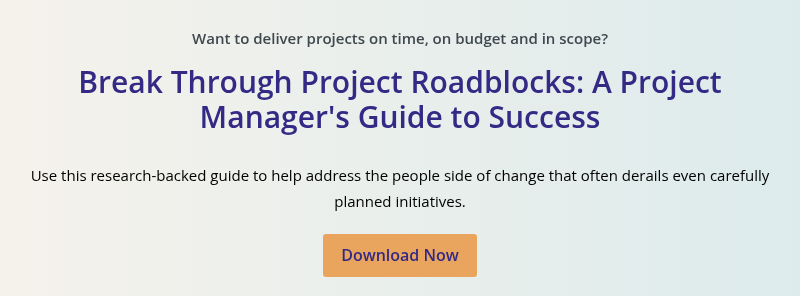Change Management and Project Management: A Side-by-Side Comparison

3 Mins
Updated: August 7, 2025
Published: May 4, 2022

The disciplines of change management and project management are both necessary when executing a project or initiative. Each discipline brings the critical structure needed for effectively implementing change and achieving the results you want. Yet, change management and project management must work together to achieve successful change. Doing so creates a unified value proposition, which sets the foundation for tactical integration and delivers value across all aspects of the project, including both the people side and technical side.
Change Management for Project Managers
Depending on your role, the meaning of change management can vary. Project managers tend to think of it as managing changing resources, process and people on a project. Others may think of it as change control or managing changes to the project itself. When we speak of change management at Prosci, we’re referring to the application of a structured process and tools for managing the people side of change to achieve a desired outcome.
Similarly, project delivery has evolved to include a variety of iterative approaches to solutions design and development, such as Agile, especially in technology projects. Regardless, you can adapt change management to work with sequential, iterative and even hybrid approaches to solutions design, development and delivery.
Compare Change Management and Project Management
The paragraphs below juxtapose change management and project management, comparing common aspects of each discipline, including focus, definition, intent, process, tools, scaling factors, measurement of success, and practitioners. Although this list highlights the differences between the disciplines, it's more important to remember that change management and project management are complementary disciplines that share a common objective: to deliver successful change.
| Definitions | |
|
Change Management – the application of a structured process and tools for leading the people side of change to achieve a desired outcome (such as ROI) on a project. |
Project Management – the use of specific knowledge, skills, tools and techniques to deliver something of value to people |
| Intent |
|
| Change Management – to ensure that impacted employees embrace, adopt and use the solution associated with the change | Project Management – to ensure that the solution is designed, developed and delivered effectively |
| Focus |
|
| Change Management – employees and stakeholders impacted by a project solution or initiative (those who must adopt and use the change) | Project Management – tasks and activities required to create and implement the technical solution associated with a change |
| Scaling Factors |
|
| Change Management – characteristics of the change, attributes of impacted organizations, and degree of "people change" required | Project Management – complexity and degree of technical change associated with the project or initiative |
| Process |
|
|
Change Management
(Source: Prosci 3-Phase Process) |
Project Management/Solutions Development “Domains”
(Source: PMBOK Guide®, 7th Edition) |
|
Tools |
|
|
Change Management
|
Project Management
|
| Success Measurement | |
|
Change Management – measurement focuses on the elements of the people side of change, including:
*Because results and outcomes depend on individuals adopting the change (i.e., the people-dependent contribution to ROI), this is a primary focus.
|
Project Management – measurement focuses on the technical side of change elements, primarily:
*In some cases, projects are considered successful at go-live or launch, despite the fact that organizational benefits may not be realized at that point. |
| Who Practices | |
|
Change Management – involves a coordinated system of support throughout the organization, not just change management practitioners:
|
Project Management – typically practiced by a project manager and a project team assigned to a specific project or initiative:
|
Project Management and Change Management
Project management and change management each contribute a critical ingredient to successful change. Although they vary in terms of focus and approach, each discipline is essential to moving your project and people from the transition state to the desired future state. Understanding how each discipline works alongside the other is the first step in achieving a unified value proposition and the strongest foundation possible for your change initiatives.




